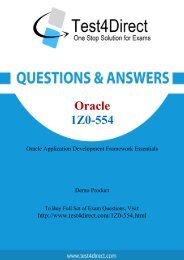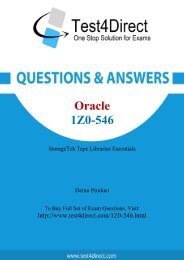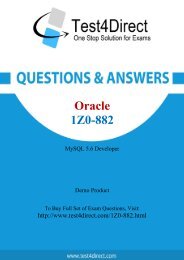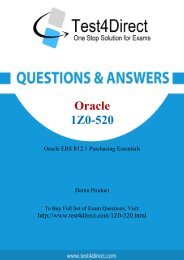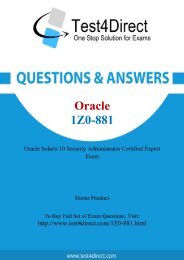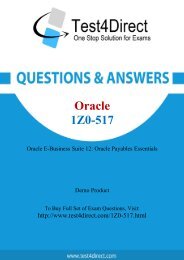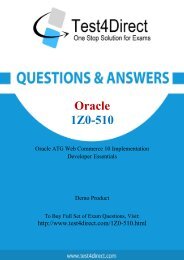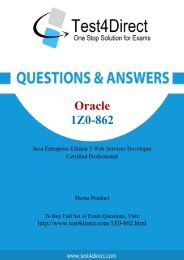Download 1Z0-898 BrainDumps to Success in career
Test4Direct provides latest PDF questions of Oracle 1Z0-898 exam. You have an opportunity to pass the Oracle 1Z0-898 exam in one go. Test4Direct is most accurate source to prepare Oracle 1Z0-898 exam as your success will become site’s responsibility after purchasing 1Z0-898 exam product. There are also lots of discounts and promotion offers that you can avail. Let’s try a free demo http://www.test4direct.com/1Z0-898.html
Test4Direct provides latest PDF questions of Oracle 1Z0-898 exam. You have an opportunity to pass the Oracle 1Z0-898 exam in one go. Test4Direct is most accurate source to prepare Oracle 1Z0-898 exam as your success will become site’s responsibility after purchasing 1Z0-898 exam product. There are also lots of discounts and promotion offers that you can avail. Let’s try a free demo http://www.test4direct.com/1Z0-898.html
You also want an ePaper? Increase the reach of your titles
YUMPU automatically turns print PDFs into web optimized ePapers that Google loves.
Oracle<br />
<strong>1Z0</strong>-<strong>898</strong><br />
Java Platform<br />
Demo Product<br />
To Buy Full Set of Exam Questions, Visit:<br />
http://www.test4direct.com/<strong>1Z0</strong>-<strong>898</strong>.html
Question: 1<br />
Entity lifecycle call-back methods may be def<strong>in</strong>ed <strong>in</strong> which three classes? (Choose three)<br />
A. Embedded classes<br />
B. Entity classes<br />
C. Abstract classes<br />
D. Entity listener classes<br />
E. Mapped super classes<br />
F. Concrete non-entity super classes<br />
Question: 2<br />
Answer: B,D,E<br />
Explanation:<br />
Reference:<br />
http://stackoverflow.com/questions/3747268/how-<strong>to</strong>-<strong>in</strong>ject-a-spr<strong>in</strong>gs-service-bean-<strong>in</strong><strong>to</strong>a-jpa-entity<br />
(See the answer, first paragraph)<br />
A developer wrote an entity class with the follow<strong>in</strong>g method:<br />
Private static Logger logger = Logger.getLogger (“myLogger”);<br />
@PrePersist<br />
@PreUpdate<br />
Public void doA () {<br />
Logger.<strong>in</strong>fo (“A”);<br />
}<br />
@PostPersist<br />
@PostUpdate<br />
Public void doB () {<br />
logger.<strong>in</strong>fo (“B”);<br />
}<br />
What will the log message conta<strong>in</strong> when an application does the follow<strong>in</strong>g?<br />
1. Beg<strong>in</strong>s a transaction<br />
2. Creates the entity<br />
3. Persists the entity<br />
4. Commits the transaction<br />
5. Beg<strong>in</strong>s the entity data<br />
6. Modifies the entity data<br />
7. Merges the entity<br />
8. Commits the second transaction<br />
A. A<br />
A<br />
B<br />
B<br />
B. A
B<br />
A<br />
B<br />
C. A<br />
B<br />
B<br />
A<br />
B<br />
D. The application will throw an exception because multiple lifecycle call-back annotations applied <strong>to</strong><br />
a s<strong>in</strong>gle method.<br />
Question: 3<br />
Question: 4<br />
Answer: B<br />
Given the follow<strong>in</strong>g code:<br />
Public void create () {<br />
try {<br />
doA () {<br />
} catch (PersistenceException e) {}<br />
try (doB) ();<br />
} catch (PersistenceException e) {}<br />
}<br />
Call<strong>in</strong>g method doA will cause an NonUniqueResultException <strong>to</strong> be thrown. Call<strong>in</strong>g method doB will<br />
cause an EntityExistsException <strong>to</strong> be thrown. What two options describe what will happen when the<br />
create method is called with<strong>in</strong> an application ' uses conta<strong>in</strong>er managed transactions? (Choose two)<br />
A. Method doB will never be called.<br />
B. The current transaction will cont<strong>in</strong>ue after doA executes.<br />
C. The current transaction will cont<strong>in</strong>ue after doB executes.<br />
D. The current transaction will be marked for rollback when doA is called.<br />
E. The current transaction will be marked for rollback when doB is called.<br />
Answer: C,E<br />
An application that uses pessimistic lock<strong>in</strong>g calls an update Data method that results <strong>in</strong> a<br />
LockTimeoutException be<strong>in</strong>g thrown. What three statements are correct? (Choose three)<br />
A. The current transaction cont<strong>in</strong>ues.<br />
B. The current statement cont<strong>in</strong>ues.<br />
C. The current transaction is rolled back.<br />
D. The current statement is rolled back.<br />
E. The LockTimeoutException can NOT be caught.<br />
F. The LockTimeoutException can be caught, and the update Data method retried.<br />
Answer: A,D,F
Question: 5<br />
A developer has created a deep entity class hierarchy with many polymorphic relationships between<br />
entitles. Which <strong>in</strong>heritance strategy, as def<strong>in</strong>ed by the <strong>in</strong>heritance Type enumerated type, will be<br />
most performed <strong>in</strong> this scenario?<br />
A. S<strong>in</strong>gle table-per-class-hierarchy (InheritanceType.SINGLE_TABLE)<br />
B. Jo<strong>in</strong>ed-subclass (<strong>in</strong>heritanceType. JOINED)<br />
C. Table-per-concrete-class (<strong>in</strong>heritanceType.TABLE_PER_CLASS)<br />
D. Polymorphic jo<strong>in</strong> table (<strong>in</strong>heritanceType. POLYMORPHIC_JOIN_TABLE)<br />
Question: 6<br />
Answer: C<br />
A developer is creat<strong>in</strong>g an entity which is mapped <strong>to</strong> a table that has a primary key constra<strong>in</strong>t<br />
def<strong>in</strong>ed on two character columns and would like <strong>to</strong> use mapp<strong>in</strong>g defaults as much as possible <strong>to</strong><br />
simplify the code. Which two mapp<strong>in</strong>g options can be chosen? (Choose two.)<br />
A. Use an @id property that constructs a private field as a concatenation of two columns.<br />
B. Use a separate class <strong>to</strong> map those two columns and use an @idclass annotation <strong>to</strong> denote I<br />
primary key field or property <strong>in</strong> the entity.<br />
C. Use a separate @Embeddable class <strong>to</strong> map those two columns and use an @EmbeddedId<br />
annotation <strong>to</strong> denote a s<strong>in</strong>gle primary key field or property <strong>in</strong> the entity.<br />
D. Use a separate @Embeddable class <strong>to</strong> map those two column and add two fields or properties the<br />
entity, each marked as @id, that correspond <strong>to</strong> the fields or properties <strong>in</strong> the embeddable class.<br />
E. Use a separate class <strong>to</strong> map those two columns. Specify that class us<strong>in</strong>g @Idclass annotation on<br />
the entity class. Add two fields or properties <strong>to</strong> the entity, each marked as @Id, that correspond <strong>to</strong><br />
the fields or properties <strong>in</strong> that separate class.<br />
Answer: B,C
THANKS FOR TRYING THE DEMO OF OUR PRODUCT<br />
Visit Our Site <strong>to</strong> Purchase the Full Set of Actual <strong>1Z0</strong>-<strong>898</strong> Exam Questions With Answers.<br />
http://www.test4direct.com/<strong>1Z0</strong>-<strong>898</strong>.html<br />
We Also Provide Practice Exam Software That Simulates Real Exam Environment And Has<br />
Many Self-Assessment Features. <strong>Download</strong> Free Product Demo From:<br />
http://www.test4direct.com/<strong>1Z0</strong>-<strong>898</strong>.html<br />
Money Back Guarantee<br />
Check Out Our Cus<strong>to</strong>mer Testimonials








